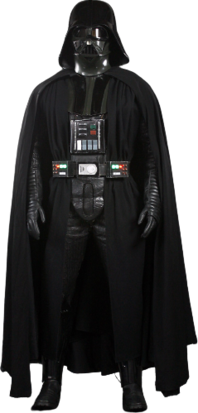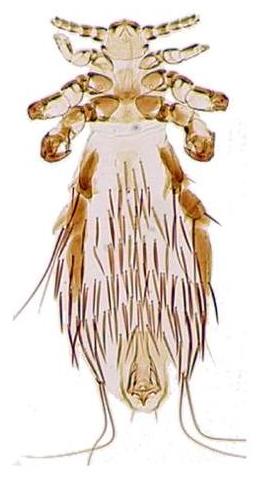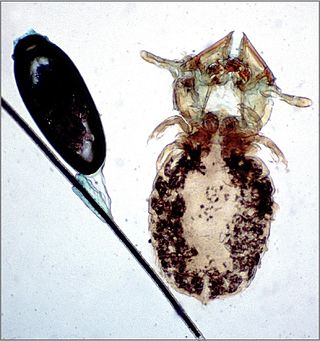
Darth Vader is a fictional character in the Star Wars franchise created by George Lucas. He was first introduced in the original film trilogy as one of the leaders of the Galactic Empire. The prequel trilogy chronicles his transformation from the Jedi Knight Anakin Skywalker into the Sith Lord Darth Vader. His metamorphosis begins when he is lured to the dark side of the Force by Chancellor Palpatine, who later becomes Emperor. After a lightsaber battle with his former mentor Obi-Wan Kenobi, Vader is severely injured and is transformed into a cyborg. He serves Palpatine for over two decades, hunting down the remaining Jedi and attempting to crush the Rebel Alliance. When Palpatine tries to kill Vader's son, Luke Skywalker, the Sith Lord turns against his master and destroys him. Vader is the husband of Padmé Amidala, the father of Luke and his twin sister Leia Organa, and the grandfather of Ben Solo.

Louse is the common name for any member of the clade Phthiraptera, which contains nearly 5,000 species of wingless parasitic insects. Phthiraptera has variously been recognized as an order, infraorder, or a parvorder, as a result of developments in phylogenetic research.

The genus Haematomyzus includes three species of lice that differ so markedly from all other lice that the genus is placed in its own family Haematomyzidae, itself monotypic within the superfamily Rhynchophthirina. These unusual lice are ectoparasites of elephants and warthogs. Their mouthparts are elongated to form a drill-like structure that allows them to penetrate the thick skin of their host.

The grey wagtail is a member of the wagtail family, Motacillidae, measuring around 18–19 cm overall length. The species looks somewhat similar to the yellow wagtail but has the yellow on its underside restricted to the throat and vent. Breeding males have a black throat. The species is widely distributed, with several populations breeding in Eurosiberia and migrating to tropical regions in Asia and Africa. The species is always associated with running water when breeding, although they may use man-made structures near streams for the nest. Outside the breeding season, they may also be seen around lakes, coasts and other watery habitats. Like other wagtails, they frequently wag their tail and fly low with undulations and they have a sharp call that is often given in flight.

The calandra lark or European calandra-lark breeds in warm temperate countries around the Mediterranean and eastwards through Turkey into northern Iran and southern Russia. It is replaced further east by its relative, the bimaculated lark.

Menoponidae is a monophyletic family of lice in the superfamily of chewing lice, Amblycera, often referred to as the chicken body louse family. They are ectoparasites of a wide range of birds including chickens, which makes them important to understand for veterinary science and for human health. However, Menoponidae are not exclusive to poultry and are common parasites for migratory birds, with more and more species being discovered every year.
Agathidium vaderi is a species of round fungus beetle in the family Leiodidae. It is found in North America. The beetle was named after the fictional character Darth Vader by Cornell University entomologists due to its shiny helmetlike head that resembles that of the Star Wars villain.

The black-and-red broadbill is a species of bird in the typical broadbill family, Eurylaimidae. It is the only species in the genus Cymbirhynchus. A large, distinctive bird, it has maroon underparts, black upperparts, a maroon neck-band, and white bars on the wings. It also has a large, two-colored, blue-and-yellow bill. The species shows slight sexual dimorphism, with females being smaller than males. No other bird in its range resembles it, though the black-and-yellow broadbill has a similar call.

Menacanthus is a genus of chewing lice which parasitise birds. The taxonomy of this genus is highly uncertain. Most taxonomies have given this genus as having over a hundred species, but recent studies have synonymised dozens of species and found other names to be invalid. Some Menacanthus species remain to be discovered, or are synonymised in error. Menacanthus lice feed on the blood of a wide variety of birds, including chickens, by piercing the quills of feathers and gnawing the epidermis. In doing so, they can spread disease and lower egg production. In Menacanthus stramineus, eggs are incubated for four or five days, each of the three nymphal stages lasts for about three days, and adult life for about twelve days. Females produce as many as four eggs in a day, averaging 1.6 eggs a day, with egg production peaking 5–6 days after reaching adulthood. On sparrows, Menacanthus lice are particularly common, and are found in many different niches, consuming blood and feathers.

Rhinonyssidae is a family of mites in the order Mesostigmata. There are about 16 genera and at least 460 described species in Rhinonyssidae.
Brueelia is a genus of bird lice in the family Philopteridae that infest Passerine (perching) birds. Lice in Brueelia are usually host specific, with more than 85% of described species each found on a single host bird species. Over 300 species of Brueelia have been described, and many more specimens that are presumed to belong to Brueelia are awaiting description and naming.

Polyplacidae is a family of lice in the suborder Anoplura, the sucking lice. Lice in this family are known commonly as the spiny rat lice. The family has a cosmopolitan distribution. As of 2010 there were 193 species.

The Ricinidae are a family of a larger group Amblycera of the chewing lice. All species are relatively large bodied avian ectoparasites. They typically exhibit low prevalence and low intensity. They feed on host blood which is atypical in chewing lice. Two or three genera are recognized.

Ricinus is a genus of chewing lice which parasitise birds. It is the largest-bodied genus of chewing lice found parasitizing Passeriformes.

Colpocephalum is a genus of chewing louse. Christian Ludwig Nitzsch named the genus in 1818. The Plenary Powers of the International Commission on Zoological Nomenclature selected Colpocephalum zebraBurmeister, 1838 as its type species in the 1950s. There are approximately 135 species in this genus, and they are ectoparasites of birds in at least a dozen different orders.
Colpocephalum californici, the California condor louse, is an extinct species of chewing louse which parasitized the California condor. In an example of coextinction, it became extinct when the remaining, Critically Endangered California condors were deloused and treated with pesticides during a captive breeding program.

Rallicola is a genus of chewing louse. It is an ectoparasite of rails and other birds. It was named by Thomas Harvey Johnston and Launcelot Harrison in 1911. There are two subgenera aside from the nominotypical subgenus: Aptericola, whose species are found on kiwi birds, and Huiacola, a monospecific subgenus consisting of Rallicola extinctus, once found on the huia.

Apterygon is a genus of louse. It is endemic to New Zealand and is an ectoparasite of kiwi birds (Apteryx). Theresa Clay circumscribed the genus in 1961. In 1947, she had referred to this genus as "New Genus D", but it was not formally named as she needed to confirm the host of her specimen as well as additional material.

Trichodectidae is a family of louse in the suborder Ischnocera. Its species are parasites of mammals. The following 19 genera are recognized:
















